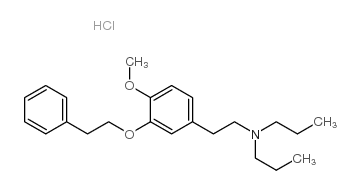NE 100 hydrochloride

NE 100 hydrochloride structure
|
Common Name | NE 100 hydrochloride | ||
|---|---|---|---|---|
| CAS Number | 149409-57-4 | Molecular Weight | 391.97500 | |
| Density | N/A | Boiling Point | 475.2ºC at 760 mmHg | |
| Molecular Formula | C23H34ClNO2 | Melting Point | N/A | |
| MSDS | USA | Flash Point | 137.4ºC | |
Use of NE 100 hydrochlorideNE-100 (hydrochloride) is a potent and selective sigma-1 receptor antagonist with an IC50 of 4.16 nM. NE-100 (hydrochloride) exerts antipsychotic activity in vivo[1]. NE-100 (hydrochloride) also suppresses ER stress-induced hippocampal cell death[2]. |
| Name | N,N-diethyl-2-[4-methoxy-3-(2-phenylethoxy)phenyl]ethanamine,hydrochloride |
|---|---|
| Synonym | More Synonyms |
| Description | NE-100 (hydrochloride) is a potent and selective sigma-1 receptor antagonist with an IC50 of 4.16 nM. NE-100 (hydrochloride) exerts antipsychotic activity in vivo[1]. NE-100 (hydrochloride) also suppresses ER stress-induced hippocampal cell death[2]. |
|---|---|
| Related Catalog | |
| References |
| Boiling Point | 475.2ºC at 760 mmHg |
|---|---|
| Molecular Formula | C23H34ClNO2 |
| Molecular Weight | 391.97500 |
| Flash Point | 137.4ºC |
| Exact Mass | 391.22800 |
| PSA | 21.70000 |
| LogP | 5.78320 |
| Vapour Pressure | 3.37E-09mmHg at 25°C |
| RIDADR | NONH for all modes of transport |
|---|
|
Diverse regulation of IP3 and ryanodine receptors by pentazocine through σ1-receptor in cardiomyocytes.
Am. J. Physiol. Heart Circ. Physiol. 305(8) , H1201-12, (2013) Although pentazocine binds to σ1-receptor (σ1R) with high affinity, the physiological relevance of its binding remains unclear. We first confirmed that σ1R stimulation with pentazocine rescues contrac... |
|
|
A sigma-1 receptor antagonist (NE-100) prevents tunicamycin-induced cell death via GRP78 induction in hippocampal cells
Biochem. Biophys. Res. Commun. 434(4) , 904-9, (2013) Highlights • NE-100 protected neuronal cells against the tunicamycin-induced cell death. • NE-100 attenuated the upregulation of CHOP induced by ER stress. • NE-100 upregulated the expressions of p50A... |
|
|
Prediction of drug-drug interactions for AUCoral of high clearance drug from in vitro data: utilization of a microtiter plate assay and a dispersion model.
Curr. Drug Metab. 7(2) , 135-46, (2006) The purpose of this study was to propose a new method to predict in vivo drug-drug interactions (DDIs) for a high clearance drug from in vitro data. As the high clearance drug, NE-100 (N, N-dipropyl-2... |
| ne 100 |
| NE-100 |